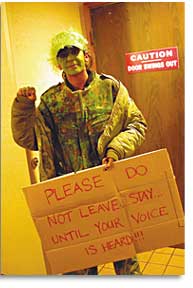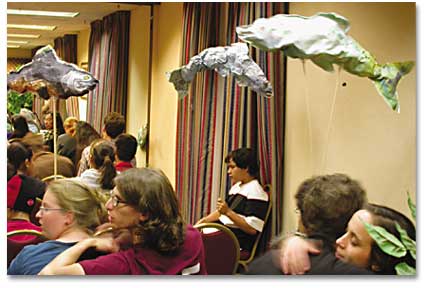|
|
 Scare quotes |
|

The people v. FERC
Eureka hearing-goers
tell agency to drop the dams
story and photos by HEIDI WALTERS
It seemed like everybody was there. Some had driven the riverine, twisty highways out of the mountains of the mid-Klamath region -- from Orleans, Somes Bar, Salmon River, Blue Creek. Others came from the mouth of the Klamath. Some moseyed over from their Eureka homes or from Arcata and McKinleyville, or traveled up from southern Humboldt or Sacramento.
There were Yurok, Karuk and Hupa people. There were non-Indians. Ocean fishers. River guides. Congresspeople, or their reps. There were college students, scientists, kids, conservationists, city people, river people and even a sympathetic farmer or two.
It was Thursday night, and inside the Red Lion in Eureka the Federal Energy Regulatory Commission was holding a hearing on its draft environmental impact report for the proposed relicensing of PacifiCorp's Klamath River dams, now owned by billionaire Warren Buffett. The Klamath Hydroelectric Project's 50-year license expired in March, and FERC is considering relicensing the project for another 30 to 50 years. This hearing was one in a series being held across the region before the public comment period ends Dec. 1.
But, just like the last time FERC came to town for a Klamath River meeting, the agency had underestimated the numbers that would show up. Even before the official start time of 7 p.m. arrived, the long, narrow room was already packed to the gills -- 250 people, the maximum allowed. Further entry was barred in order not to incur the wrath of the fire marshal or induce death by suffocation among the attendees.
So for the next nearly five hours, about 150 thwarted people wriggled up and down the long, tight, packed hallway outside the hearing doors, waiting for a chance to be let in as others left. Some of them gave up and went home. Many wandered in and out of a room across the hall from the hearing that the Northcoast Environmental Center had reserved for the anticipated stranded attendees. There were speeches, protest signs -- "Un-dam the Klamath!" -- and informational posters and a new video by the Klamath Salmon Media Collaborative called "Solving the Klamath Crisis: Keeping Farms and Fish Alive."
Inside the NEC room, biologist Pat Higgins was explaining to a passerby the Klamath's water quality and temperature problems and the dams and dikes that have caused them, and how FERC's recommendations in the draft EIS fall short. He and other critics, including the National Marine Fisheries Service, say FERC's draft EIS analyzes the removal of just two dams, when it should consider removal of all four of the lower dams -- Copco I and II, J.C. Boyle, Iron Gate -- that have blocked fish from 350 miles of river for decades. FERC staff, instead, recommend trapping and trucking some Chinook salmon around the dams to repopulate a portion of upstream river. Critics say such a plan is weak, and besides would do nothing for the other species who once had passage to the upper reaches, such as the coho salmon, steelhead, lamprey and green sturgeon.
"Trap and haul -- they tried it in the `60s, when they built Iron Gate Dam, and it didn't work," Higgins said. "I think they need to take the [four main hydro] dams out. They need to leave Link River Dam, which regulates water levels in Klamath Lake, for the fish. And if they leave Keno Dam, they need to restore the wetlands adjacent to the Klamath River in that reach."
Back out in the hallway, the crowd grew. Even Toxic Algae Monster was there, haunting a corner by the kitchen doors in her green fuzzy hat, green-painted face and green clothes and holding a big cardboard sign that said "Please don't leave. Stay until your voice is heard!!!" Rani Rhoar, who's lived in Orleans by the Klamath River for 12 years, said she was at FERC's hearing in Yreka the day before and at a water quality board meeting in Sacramento before that. But this was the first time she'd dressed up as the toxic algae that has been increasingly plaguing the river and its reservoirs.
"When I first moved to the Klamath River, I used to swim in it," she said. "Today, I don't swim in it, I don't raft in it, I don't touch it. They need to remove the Klamath dams and restore the river. And make humane decisions."
Standing near the algae monster were fellow Orleans residents Quentin Peterson, with blue and purple dyed hair and earrings, and Richard Buhler, whose bright red dyed hair, red-satin-lined black trench coat and kind young face made him look like a friendly devil. (Unlike the algae monster, this is their usual look.) They grew up in Orleans. Peterson's a firefighter, crab fisherman and part-time river guide. He said he tries to make it to every river-related meeting he can. "My dad was a river guide my whole life, drift-boat guiding and rafting trips. I was raised in a boat. I caught my first fish when I was 3 years old." He and Buhler reminisced about the rope swing they used to play on that hung from a bridge over the river. "Now I won't go in the Klamath," Peterson said. "I won't let my animals in the water. I took people out rafting a couple times this summer, but we had to go to the Salmon River instead. We canceled a couple of trips. I was there for the fish kills in 2002 -- there were so many dead fish, we couldn't get the boat in the water. Also, half the reason I go to the river is its beauty. Now it's gross. There's algae hanging off the rocks, every pool is stagnant."
Buhler, who crews on salmon and crab boats, said for this year's salmon season -- closed in Oregon and California, for the most part, because of low salmon counts in the Klamath -- he had to go to Alaska to work. "I would prefer to stay here," he said. "But if you fish for a livelihood, you can't skip a season."
Down the hall, Nat Pennington wanted to talk about the Salmon River, where he lives. It's un-dammed, and the cleanest major tributary to the Klamath River. But it has had "the three lowest runs of spring and fall Chinook in record history," said Pennington. "So we feel like the water quality issues created in the Klamath are a major impact on our salmon runs."
Near him stood Jason Reed, who'd just been interviewed by a TV station. Like many of the young men there that night, he wore a knit cap with traditional tribal designs. Reed, a College of the Redwoods student, is Karuk and Hupa. "Salmon is like a family to us," he said. "What are we going to do when the salmon is gone? I was raised on the river. I remember there being lots of fish. I remember packing -- in gunny sack's -- like, five fish at a time. And this was just one round. Pack 'em, clean 'em, and go back to the river again for more. Today, we're lucky if we get five."
Back at the other end, Hoopa Valley Tribal chairman Clifford Lyle Marshall and the tribe's senior attorney, Grett Hurley, stood talking. "I'm surprised that there aren't more people here," Marshall said. "[But] this is a healthy showing. It's a reflection of the widespread concern. It's not just Indians and it's not just fishermen. It's people from Eureka. And other places."
Finally, some space opened up inside the hearing
r oom.
There, rows and rows of people -- including several children,
holding large salmon puppets on sticks, from the American Indian
Academy Charter School in McKinleyville -- faced a table at which
sat three FERC men. One after another, the people stood and delivered
lengthy speeches, some fact-filled, others emotional. The FERC
men, their job here simply to listen, sat silently -- white,
gray, impassive, eyelids fluttering shut. They hadn't taken a
break, and no doubt were weary. Even so, the scene seemed like
the personification of a choked river full of desperate salmon
leaping at an immovable concrete wall.
oom.
There, rows and rows of people -- including several children,
holding large salmon puppets on sticks, from the American Indian
Academy Charter School in McKinleyville -- faced a table at which
sat three FERC men. One after another, the people stood and delivered
lengthy speeches, some fact-filled, others emotional. The FERC
men, their job here simply to listen, sat silently -- white,
gray, impassive, eyelids fluttering shut. They hadn't taken a
break, and no doubt were weary. Even so, the scene seemed like
the personification of a choked river full of desperate salmon
leaping at an immovable concrete wall.
State Senator Wesley Chesbro was just getting up to speak. "You can hear the frustration in the voices" of these people, he said. The draft EIS, he said, was flawed, and FERC should tear down not two dams, but four -- and the state would be there with the cash to help restore the river.
Right: Rani Rhoar, toxic algae monster.
Then a familiar figure took the floor. As he spoke, the crowd tensed and glared at him. "My name is Dennis Mayo, I'm a native Humboldt County boy," he said. He warned that he might offend some people. "I'm here tonight to make comments from the farming and ranching community, and also as a recreational fisherman and a past commercial fisherman and an avid duck and goose hunter. I have farmed and ranched throughout the Klamath Basin and I currently have stock on feed in the upper Klamath. My community is sick and tired of the almost xenophobic way the environmental groups have attacked us and our livelihood. It has to stop. In the past we have been played off against the native and fishing communities in every conceivable way."
Mayo accused environmentalists of hurting "working folks" and helping destroy rural communities. He told FERC they were not to be trusted. But then he said: "We want FERC to know that we don't need these dams for our irrigation, or flood control, and that we are getting no benefit from the meager electrical output. We want FERC to know that the Klamath dams have not only lived out their usefulness as electric generators, they might have also lived out the life blood of the river: the salmon. If that happens and the salmon die, also dies the life blood to the soul of the Klamath's native peoples. That cannot be allowed to happen. We want to tell FERC that we will see to it that our neighbors are not stomped on, broken or bankrupted as we make sure these dams are decommissioned."
He implored the by-now confused "enviro community" to "get off the superiority trip," and he asked the Northcoast Environmental Center to pull from its website "the discriminatory caricature of a fat cowboy/potato farmer with his pockets stuffed full of cash."
After that, a Yurok man remembered three kids who'd
gone swimming in the river, even though they were told not to,
and came out covered in bumps. A commercial fisherman said he's
fished for 30 years in the ocean, and though he's suffered from
the  recent
restrictions, his "heart goes out to the Indians" more.
Lyn Risling, Karuk-Yurok and a Hoopa Valley Tribe member, likened
the loss of traditional foods such as salmon, deer, acorns and
berries to a continued genocide of her people, ravaged now by
diabetes and other ills.
recent
restrictions, his "heart goes out to the Indians" more.
Lyn Risling, Karuk-Yurok and a Hoopa Valley Tribe member, likened
the loss of traditional foods such as salmon, deer, acorns and
berries to a continued genocide of her people, ravaged now by
diabetes and other ills.
Back out in the hallway, Dale Ann Frye Sherman -- half Yurok, half Tolowa -- and Yurok Tribe members David Gensaw, Sr. and Willard Carlson, Jr. were getting ready to leave. They hadn't had a chance to give their comments yet, but midnight was approaching and some people had to work the next day. They seemed deflated.
"They're going to do it anyway," said Gensaw about the FERC team. "Their attitude -- they don't even want to be here. They're falling asleep. And why are we pleading? We should be demanding!"
"They don't even live here," said Sherman.
"If they don't tear those dams down, and they get relicensed, the writing's on the wall," said Gensaw. "The salmon will be gone."
"And, in essence what that means is, we as a people will be gone," added Sherman.
"You can't convince me it wasn't a conspiracy," said Gensaw. "If they kill the system, if they kill the fish, then they won't have a fight for the water. The water's like oil. We've got a war on because of oil. But you can live without oil."
They talked about the fish wars in the 1970s when the federal government showed up in the Indian river communities wearing riot gear while the Indians fought for their traditional fishing rights.
But there was a glimmer of hope, they admitted. "This is the first time I've come to the Red Lion [for a hearing] in years that the people didn't say, `The Native Americans overfished with their gill nets,'" said Carlson, who lives on Blue Creek, a tributary to the Klamath.
"They used to be our enemies," said Gensaw about all the non-Indians at the hearing. "Now they're our allies."
COVER STORY | IN
THE NEWS | STAGE
MATTERS | OFF
THE PAVEMENT
BOOKNOTES | TALK OF THE TABLE | THE HUM | CALENDAR
Comments? Write a letter!
© Copyright 2006, North Coast Journal, Inc.

